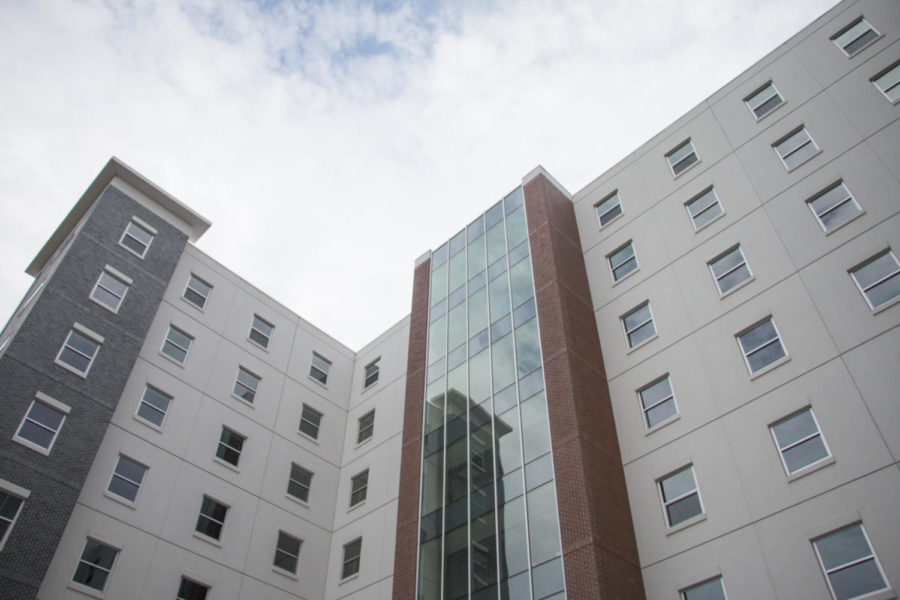The role of residency: City, university discuss housing issues in Ames
Named after former president Gregory Geoffroy, Geoffroy Hall holds 784 students and is seven stories tall.
November 6, 2017
For the first time in a while, Iowa State has more beds available to its students than it does students who need them.
Nine years ago, housing on-campus looked entirely different.
“Since 2008, demand for on-campus student housing has grown about 58 percent,” said Pete Englin, director of the Department of Residence. “We only had 7,900 people living on campus [which was] the lowest it had been since 1981.”
A constant, however, has been a draw for students to live in off-campus housing.
Brittney Rutherford, program coordinator for Iowa State, said when it comes to finding safe housing, “You first have to look at physical appearance [of the housing] to make sure it accommodates the students and that it aligns with state and university codes.
“When it comes to the students themselves, we educate and have the student wellness office. We make sure there are plans are in place for students in case of an emergency.”
And Iowa State is no stranger to accommodating students — particularly in 2008 when it experienced the uptick in need for on-campus housing and the lagging resources of what already existed.
In order to combat this, Iowa State needed to make some quick adjustments, such as building Geoffroy Hall, a new residence hall on Lincoln Way.
Now, accommodating housing for students is not as large a problem as it was back in 2008, Rutherford said, and neither is getting students the help they need.
“There’s help on the Iowa State website with many different avenues to help ISU students use the resources and come to talk to us,” Rutherford said. “If you’re having issues, they can be easily solved, and students can easily be helped. Please talk to us, our staff, we have departments to help you.”
This raises the question, however, what about students off campus — the ones who do not live in the jurisdiction of Iowa State?
“Our role is to come in and help someone if they need a place to live,” Rutherford said. “There are some resources that the university can help with, but not with the [off-campus] housing department.”
Student Legal Services is the proper place to go if a student is having issues with housing off-campus.
Englin listed some other issues students may run into, as well.
“In our case, if a student lives with a shortage of money and they come to us, [if the leases are run through Iowa State] we will release them from their contract,” Englin said. “If they are off-campus and they’ve signed a lease… there is very little we can do.
“What we will often do is refer them to Student Legal Services to see if there is anything in the lease agreement that they signed with someone else to see if it gives them any sort of flexibility and latitude,” he said.
Englin said another thing Iowa State does is to try and help find the source of a student’s financial struggles.
“We try to get the departments together and try to put a package together to help them financially. If a student is struggling with rent, then they’re struggling with tuition, and if they’re struggling with tuition, then they’re struggling buying books, and if they’re struggling buying books, then they’re struggling with class,” Englin said.
Many students choose off-campus because they feel it may be cheaper or will have more independence than on-campus. Englin negated this.
“We have a number of different price points on campus, and I would argue if you look at some of those apartment communities you can’t find cheaper housing in the Ames community,” Englin said.
Englin also touched on a new law passed by the Iowa Legislature this year that declared a current Ames housing ordinance unconstitutional.
Currently, the city of Ames limits the number of people in rental units to one family or three unrelated people.
The current ordinance in Ames, which says that cities may not restrict occupancy based on familial or non-familial status will be moot after Jan. 1, 2018 when the law goes into effect.
“Now, it will be interesting to see the changes that the state made around how many unrelated people can live in a residence,” Englin said. “Because there are times in our history at Iowa State you might have five, six, seven, eight people living in a house they all rent. You know they’re putting $150 toward that. They changed that to [three] people living in a building, but what does that mean for the future?”

















